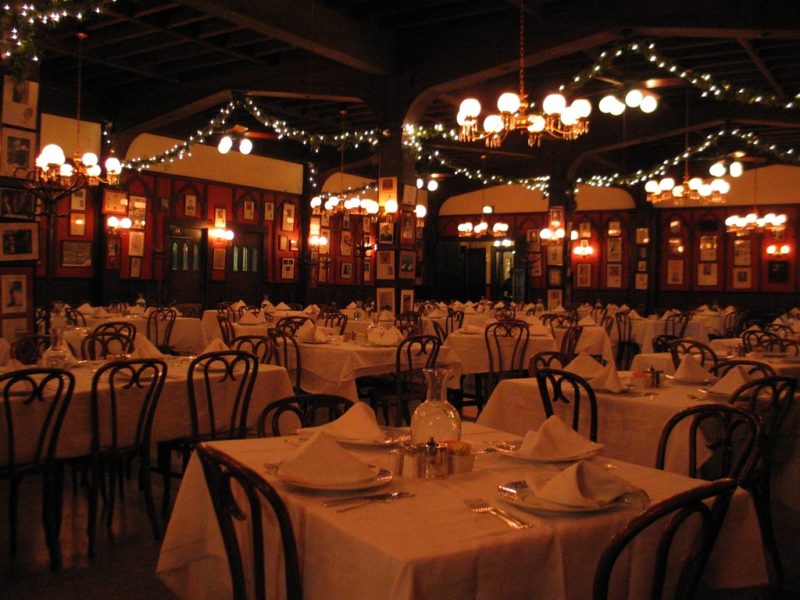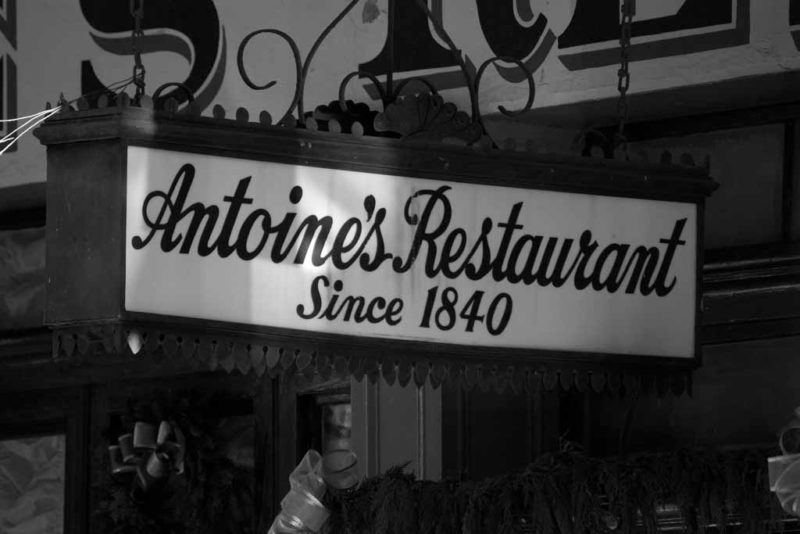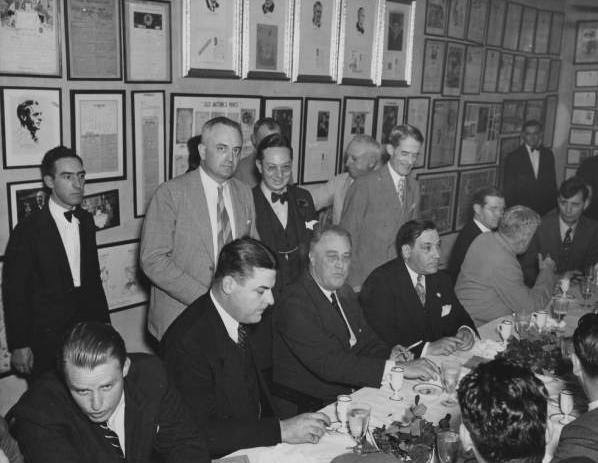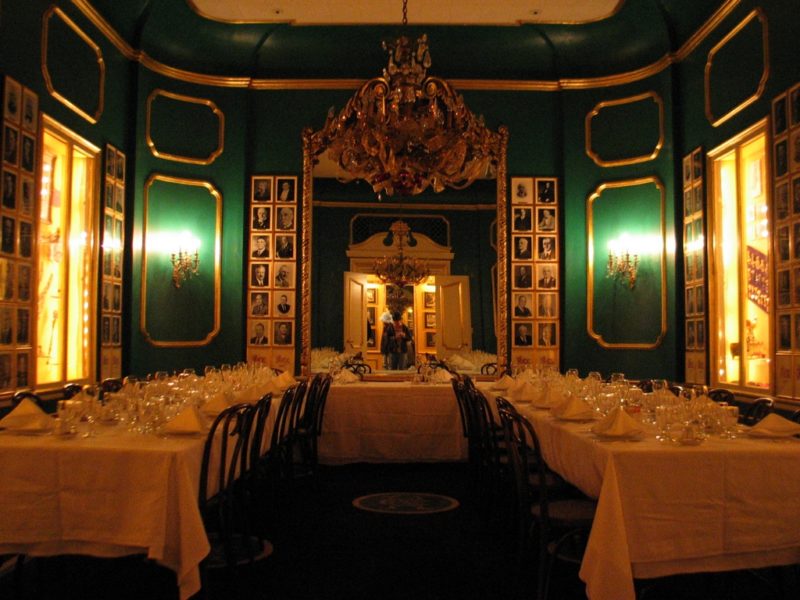
One of Antoine’s luxurious dining rooms. Photo by J. Shyun via Flickr with permission under the Creative Commons
Originally founded in 1840 by a 27-year-old French immigrant named Antoine Alciatore, Antoine’s Restaurant today holds the distinction of being the oldest continually operating family owned restaurant in the United States. For 169 years the Alciatore-Guste family has owned and operated this world famous restaurant through everything that the world and New Orleans has thrown at it. Besting the Civil War, World Wars I and II, the Great Depression, and most recently the devastation of Hurricanes Katrina and Rita, Antoine’s is more than a place to dine. It is a cultural icon.
Addresses
The world famous Antoine’s Restaurant has held just two locations since its opening. Interestingly enough, both addresses are within one block of each other. Antoine’s was founded within a modest little building facing the slave mart, located at No. 50 Rue Saint Louis (Antoine’s Restaurant. Centennial Souvenir, Antoine’s Restaurant. 1940 p. 5).
In 1868, the restaurant moved down the street to 65 St. Louis Street, later renamed 713 St. Louis Street after the restructuring of the street numbering system (Guste, Roy F. Jr. Antoine’s Restaurant Cookbook: Since 1840. New Orleans, LA: Guste Publishing).
Founder Antoine Alciatore
Antoine’s classic sign in the French Quarter. Photo by Chris McCorkle with permission under the Creative Commons.
Mr. Antoine “Angelo” Alciatore immigrated to America from Marseilles, France in the early to mid 1800s. Like so many others who came to America in search of wealth and prosperity, Mr. Alciatore made berth in New York City. After spending two disappointing years in New York, he moved south to New Orleans, Louisiana. Feeling right at home in this French-speaking municipality, Mr. Alciatore sent word to his fiance in New York, Julie Sophie Freyss, and within five years the two were married. It was during this time that he established the Pension Alciatore, which was both a boarding house and a restaurant located at 50 St. Louis Street (Guste, Roy F. Jr. Antoine’s Restaurant Cookbook: Since 1840. New Orleans, LA: Guste Publishing).
By the 1860s, the Pension Alciatore had become immensely popular and the family found that they were in need of a new and larger location (Guste, Roy F. Jr. Antoine’s Restaurant Cookbook: Since 1840. New Orleans, LA: Guste Publishing). Mr. Alciatore’s search for a permanent business location ended on August 20, 1868, when he purchased a former home at 65 St. Louis Street for 12,300 piastres (Cajun-French slang for US Dollar) (Historic American Buildings Survey. 1933. “Vieux Carre Squares, Antoine’s Restaurant, 713-717 Saint Louis Street, New Orleans, Orleans Parish, LA.” Washington, DC: Library of Congress, Prints and Photograph Division). Aside from being large enough, the building was very easy to move into, as it was less than a block away (1885. “New Orleans, Louisiana: Volume Two.” New York, NY: Sanborn Map and Publishing Co. sheets 41b, 42a. Retrieved March 11, 2009). It would be at this location that the Alciatore family would become an institution and Mr. Antoine Alciatore would become a legend. Still operating as a pension (boarding house and restaurant), the business adopted a new name, Antoine’s Restaurant.
Upon Alciatore’s death in France in 1874, the restaurant was hugely popular and well on the way to becoming what it is today. His wife took care of running the restaurant until their son, Jules Alciatore, was educated and old enough to become the proprietor of the family-run restaurant in 1887 (Guste, Roy F. Jr. Antoine’s Restaurant Cookbook: Since 1840. New Orleans, LA: Guste Publishing)(Antoine’s Restaurant. 2004. “Antoine’s Restaurant: Since 1840.” New Orleans, LA: Antoine’s Restaurant. Retrieved March 11, 2009). Jules Alciatore managed the restaurant until 1930. (Antoine’s Restaurant. Souvenir du Restaurant Antione. New Orleans, 1941 p. 6).
Cultural Exhibition

Franklin D. Roosevelt dines with Louisiana politicians at Antoine’s, including the Mayor of New Orleans (Robert Maestri) and the Governor (Richard Leche). 1937. Photo provided by Infrogmation of New Orleans via Flickr, with permission under the Creative Commons.
One of the things that Antoine’s is famous for is its ambiance. Throughout the restaurant, there are historical artifacts from Mardi Gras krewes and world-famous cookbooks to memorabilia from New Orleans history during events like the Great Depression (Roy F. Guste, “Antoine’s Restaurant: Since 1840” (Carbery-Guste 1978) 37, 59). Dispersed over two floors, Antoine’s 15 rooms are all of varying sizes and themes (Antoine’s Restaurant. 2004. “Antoine’s Restaurant: Since 1840.” New Orleans, LA: Antoine’s Restaurant. Retrieved March 11, 2009). Each having it’s own unique history, these dining rooms offer themselves up as testaments to New Orleans’ rich and one-of-a-kind culture. The average guest dining at the restaurant likely will be seated in one of two rooms, either the main dining room or the large annex room (affectionately known as the Red Room). A veritable museum of American and local popular culture, the large annex room is beautifully adorned with signed pictures, posters, and other print media of the many famous and VIP status guests who have dined at the restaurant over the decades. This ever growing list of notable guests includes Presidents Franklin Roosevelt, Calvin Coolidge and Bill Clinton; Entertainers Bob Hope, Al Jolson and Whoopi Goldberg; World figures Pope John Paul II, Duke and Duchess of Windsor circa 1949, and World War I French military hero Marshal Ferdinand Foch.
The Rex Room

Antoine’s opulent Rex Room. Photo by J. Shyun via Flickr with permission under the Creative Commons
Other prominent rooms are the Hermes Room (recently converted into the Hermes Bar), Rex Room, Dungeon, 1840 Room, Proteus Room, 12th Night Room, and Mystery Room (Antoine’s Restaurant. 2004. “Antoine’s Restaurant: Since 1840.” New Orleans, LA: Antoine’s Restaurant. Retrieved March 11, 2009). Four of the aforementioned rooms, Hermes, Rex, Proteus, and Twelfth Night, are each dedicated to separate Carnival Krewes. Descendant and third-generation proprietor, Roy Alciatore, created the grandest of these three rooms, the Rex Room. Dedicated to the Krewe of Rex and painted in the colors of Carnival (purple, green and gold), the Rex Room is lavishly gilded with gold trimmings that run from the baseboards to the ceiling. Just like a museum, the Rex Room holds several scepters and crowns of past kings and queens as well as various ball invitations from over the years. However, most wonderfully displayed on the walls in chronological order are pictures of every king of Rex from the krewe’s inception in 1872 to present day (Guste, Roy F. Jr. Antoine’s Restaurant Cookbook: Since 1840. New Orleans, LA: Guste Publishing).
Paranormal Culture
It is said that any spiritual activity deepens the probability of a place’s aptitude for harboring other activity of the paranormal. This is a belief heavily upheld by the patrons and staff of Antoine’s. An interview with Renee Smith, a server at the restaurant, detailed this history:
“Antoine Alciatore haunts the rooms and premises of the restaurant almost every night, but he is not the only ghost to inhabit the establishment. From room to room, these spirits are tied to the objects displaying them. One such tale would be the photograph of a woman in front of a dresser that resides in the building’s 1840 room, seemingly normal but for the skull in replace of her face; the disturbing aspect of this for those affiliated with the restaurant is that the photograph is purportedly un-doctored. The restaurant even hosted a team of paranormal investigators with National Geographic who, upon their inspection, labeled it as a hub of supernatural activity (though this information was not publicly disclosed or published)” (Smith, Renee. Personal Interview with Fallon Goodman, 3 Nov. 2011). Whether or not the establishment genuinely serves as a hub of paranormal activity, it is the community’s continued belief in the stories of the building that enable the supernatural history to thrive as its own entity, almost independent of the restaurant itself. Whether or not this belief in the paranormal is grounded in scientific fact, however, remains unknown, but is no less real or important to Antoine’s and the outlying community.
Points of Interest
- Marshal Foch was honored by Antoine’s when, in 1921, proprietor Jules Alciatore created and named an oyster dish after him. The dish “Huitres a la Foch” is still on the menu today (Guste, Roy F. Jr. Antoine’s Restaurant Cookbook: Since 1840. New Orleans, LA: Guste Publishing).
- After dining at Antoine’s, famed director Cecil B. DeMille said of his pompano en papillote, “Many a chef have created a dish, but only God could have created that fish.” (Antoine’s Restaurant. 2004. “Antoine’s Restaurant: Since 1840.” New Orleans, LA: Antoine’s Restaurant. Retrieved March 11, 2009).
- In 1948, Francis Parkinson Keyes, an author of the southern renaissance, wrote a murder mystery called Dinner at Antoine’s, which begins with dinner in the 1840 Room (Antoine’s Restaurant. 2004. “Accolades.” New Orleans, LA: Antoine’s Restaurant. Retrieved March 11, 2009).








